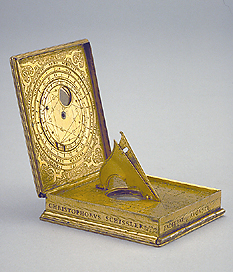
 |
| Catalogue |
 |
 Astronomical Compendium The inside of the upper leaf has a pierced volvelle with aspectarium. The volvelle is engraved with lunar hours divided to the half hour and numbered 1 to 12 twice, and surrounding the volvelle are engraved solar hours, divided to the half hour, numbered 1 to 12 twice. Surrounding the hours is the inscription '[three dots] IN HIS TRIBVS CIRCVLIS IN VENITUR DIES LUNAE ET HORAS NOCTIS ? ?' and around this are the names of the 16 main directions in German. There is a central hole for a vane, which is now missing. The spandrels space is filled with decoration similar to the outside of the leaf. The inside of the main box has a polar gnomon horizontal dial, with common hours engraved alternatively from 5 to 12 to 7 and from V to XII to VII, with punches for the half hours, for the latitudes 45?, 48?, 51? and 54?. There are two additional hour lines for the latitude 45?, for 4 a.m. and 8 p.m. The edge of the style of the gnomon is sliding and can be adjusted for the above mentioned latitudes. The compass, fixed to the following leaf, can be seen at the centre of the dial. In the space below the hour lines is a foliage decoration. The other side of the plate in the main box is engraved with a list of 32 cities and latitudes: 'LVT3ELBVRG 50', 'AMSTERDAM 52', 'MECHELN 51', 'GHELDERN 51', 'ANTORFF 51', 'BRVSSEL 51', 'L?VEN 51', 'GHENT 51', 'ACH 51', 'CL?FF 51', 'GV[umlaut]LCH 51', 'VTRICH 52', 'C?LN 51', 'M?NT3 50', 'COBLENT3 50', 'FRANCKFORT 50', 'NVRNBERG 49', 'STRASBVRG 49', 'WITENBERG 52', 'AVGSPVRG 48', 'LEYPT3IG 51', 'DRESSEN 51', 'WIEN 48', 'PRAG 50', 'VIM 48', 'HALL 52', 'STETIN 54', 'BERLIN 54', 'ROSTOCK 54', 'BREMEN 54', 'HAMBVRG 54', 'BRANDENBVRG 52'. The other leaf is hinged on the opposite edge of the main box as the first leaf. The inside has a compass, with the cardinal points indicated 'SE', 'OR', 'ME', 'OC'. Around the compass box is a rotating arm, moving on a scale of degrees. The cardinal points are engraved in Latin and the scale is divided in quadrants, divided to ten, subdivided to two, numbered from ten to 90 by ten, with [0] at the top. The space between the scale and the compass case, as the spandrels space, is filled with strapwork and foliage. The outside of the leaf has a circular table for converting unequal hours, engraved 1 to 12 twice, and common hours engraved I to XII twice, with dots indicating the half hours. The horizon line is marked 'LINIAE HORIZON ? ORT?' and 'LINIAE HORIZON ? OCCA?'. The symbols of the zodiac signs are engraved along a vertical line with non-linear divisions. The volvelle and the arm are missing. The spandrel space is filled with the same style of strapwork and foliage. On the sides of the box is the signature and date 'CHRISTOPHORVS SCHISSLER FACIEBAT AVGVSTE VINDELICORVM ANNO DOMINI ? 15 ? 63 ?'. The instrument was presented by A.W. Franks in 1867 and is described in F. A. B. Ward, A Catalogue of European Scientific Instruments in the Department of Medieval and Later Antiquities of the British Museum (London, 1981), p. 121, no.349. Ilaria Meliconi |



